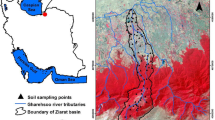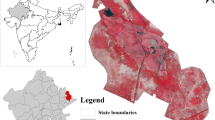Abstract
This study introduces a method to quantify the scenic value of wetland landscapes and provides the guidance on the allocation of efforts for the purpose of preserving the most important environments. Dongting Lake, a traditional tourist location, is one of the five largest freshwater lakes in China and a Grade 5A National Scenic Region. This study objectively analyzes the scenic resources of South Dongting Lake, and presents a model based on Quantification Theory I to assess wetland scenic landscapes. Employing a multilinear regression relationship between landscape factors and their associated scenic value, we built up the Wetland Landscape Quantification Model (WLQM), which was used to classify 221 landscapes into five grades. Finally, some suggestions are proposed regarding quantitative assessment and its use for the sustainable development of wetland environments.
Similar content being viewed by others

References
Auther L M, 1997. Predicting scenic beauty of forest environment some empirical tests. Forest Science, 23(1): 78–85.
Beau B Beza, 2010. The aesthetic value of a mountain landscape: A study of the Mt. Everest Trek. Landscape Urban Plan, 97(4): 306–317. doi: 10.1016/j.landurbplan.2010.07.003
Beijing Forestry University, 1998. Statistics. Beijing: China Forestry Press, 262–272. (in Chinese)
Bulut, Z, Yilmaz, H, 2009. Determination of waterscape beauties through visual quality assessment method. Environmental Monitoring and Assessment, 154(1–4): 459–468. doi: 10.1007/s10661-008-0412-5
Dong Wenquan, Zhou Guangya, Xia Lixian, 1993. Quantification theory and its application. Changchun: Jilin People’s Press, 1–39. (in Chinese)
Genoveva V Tzolova, 1995. An experiment in greenway analysis and assessment: The Danube River. Landscape Urban Plan, 33(1–3): 283–294.
Guo Laixi, Wu Bihu, 2000. Type assessment and classification system of tourism resources in China. Acta Geographica Sinica, 55(3): 294–301. (in Chinese)
Han K T, 2010. An exploration of relationships among the responses to natural scenes scenic beauty, preference and restoration. Environment and Behavior, 42(2): 243–270. doi: 10.1177/0013916509333875
He Ping, Wang Baozhong, 2002. The preliminary study on landscape culture orientation and exploitation in the South Dongting Lake Wetland. Chinese Geographical Science, 12(3): 254–261.
He Ping, Wang Baozhong, 2003. Study on landscape ecological assessment and eco-tourism in the South Dongting Lake Wetland. Journal of Environmental Sciences, 15(2): 271–278.
Jonathan Lyon, Cynthia L Sagers, 2002. Correspondence analysis of functional groups in a riparian landscape. Plant Ecology, 164(2): 171–183. doi: 10.1023/A:1021225819446
Julianna Priskin, 2001. Assessment of natural resources for nature-based tourism: The case of the central coast region of western Australia. Tourism Management, 22(6): 637–648. doi: 10.1016/S0261-5177(01)00039-5
Junker B, Buchecker M, 2008. Aesthetic preferences versus ecological objectives in river restorations. Landscape Urban Plan, 85(3–4): 141–154. doi: 10.1016/j.landurbplan.2007.11.002
Li Xiuzhen, He Hong S, Wang Xugao et al., 2004. Evaluating the effectiveness of neutral landscape models to represent a real landscape. Landscape Urban Plan, 69(1): 137–148. doi: 10.1016/j.landurbplan.2003.10.037
Li Xiuzhen, Xiao Duning, Rob H Jongman et al., 2003. Spatial modeling on the nutrient retention of an estuary wetland. Ecological Modeling, 167(1–2): 33–46. doi: 10.1016/S0304-3800(03)00170-4
Lin Geng, 2000. Tourism value about an isolated system inlaid with water and land. Economic Geography, 20(5): 84–87. (in Chinese)
National Tourism Administration of China, Institute of Geographic Sciences and Natural Resources Research, 2003. Classification, investigation and assessment of tourism resources in China (GB/T18972-2003). (in Chinese)
Peter Howard, David Pinder, 2003. Cultural heritage and sustainability in the coastal zone: Experiences in southwest England. Journal of Cultural Heritage, 4(1): 57–68. doi: 10.1016/S1296-2074(03)00008-6
Phillips M R, Edwards A M, Willams A T, 2010. An incremental scenic assessment of the Glamorgan Heritage Coast, UK. Geographical Journal, 176(4): 291–303. doi: 10.1111/j.1475-4959.2010.00361.x
Smardon R C, 1983. The future of wetland: assessing visual cultural value. NY: Allanheld and Osmum, 18–59.
State Forestry Bureau of China, 2001. Wetland Management and Research Methods. Beijing: China Forestry Press, 88–98. (in Chinese)
Terry C Daniel, 2001. Whither scenic beauty? Visual landscape quality assessment in the 21st century. Landscape Urban Plan, 54(1–4): 267–281. doi: 10.1016/S0169-2046(01)00141-4
Wang Baozhong, An Shuqing, He Ping et al., 2006a. Study on eco-tourism of the world heritage resources in the South Dongting Lake Wetland, China. Proceedings of the China Association for Science and Technology, 2(1): 735–740, 867.
Wang Baozhong, Wang Baoming, He Ping, 2006b. Aesthetics theory and method of landscape resource assessment. Chinese Journal Applied Ecology, 17(9): 1733–1739. (in Chinese)
Wang Baozhong, He Ping, An Shuqing, 2004. Study on eco- tourism value of the world cultural heritage resources in the South Dongting Lake Wetland. Journal of Beijing Forestry University, 3(4): 10–16. (in Chinese)
Wang Baozhong, He Ping, An Shuqing, 2005a. Study on the structure and characteristics of landscape cultures in the South Dongting Lake Wetland. Wetland Science, 3(4): 241–248. (in Chinese)
Wang Baozhong, He Ping, Shen Shouyun, 2005b. Features and its application strategy of the world heritage resources in the South Dongting Lake Wetland. Economic Geography, 25(4): 585–589. (in Chinese)
Wang Baozhong, Wang Caixia, 2006. Study on the landscape structure, feature and sustainability of South Dongting Lake wetland ecosystem. Central South Forest Inventory and Planning, 25(1): 25–30. (in Chinese)
Xiao Duning, Zhong Linsheng, 1998. Ecological Principles of Landscape Classification and Assessment. Chinese Journal of Applied Ecology, 9(2): 217–221. (in Chinese)
Xu Shubai, 1998. Practical Decision Method: Principle of AHP. Tianjin: Tianjin University Press. 10–40. (in Chinese)
Xue Huifeng, 1994. Study on assessment theory of landscape aesthetics value in the water region. Economic Geography, 14(3): 38–42. (in Chinese)
Yang Gexun, 1990. Principle of Ecological Modeling Method. Shanghai: Shanghai Translation Press, 45–86. (in Chinese)
Yang Lan, Shao Zhenghui, Yang Kai, 2002. The status of wetland landscape protection and development. Forest Investigation and Planning, (3): 25–26. (in Chinese)
Yuan Jianqiong, 2008. State-led ecotourism development and nature conservation: A case study of Changbai Mountain Biosphere Reserve, China. Ecology and Society, 13(2): 55–61.
Yue Liang, Li Peicheng, Hu Jianping, 1998. Overall evaluation of landscape water resource. Journal of Xi’an Jiaotong University, 32(2): 102–104. (in Chinese)
Yvonne Pfluger, Allan Rackham, Scott Larned, 2010. The aesthetic value of river flows: An assessment of flow preferences for large and small rivers. Landscape Urban Plan, 95(1–2): 68–78. doi: 10.1016/j.landurbplan.2009.12.004
Zhong Linsheng, Buckley R, Xie Ting, 2007. Chinese perspectives on tourism eco-certification. Annals of Tourism Research, 34(3): 808–811. doi: 10.1016/j.annals.2007.03.003
Zhong Linsheng, Deng Jinyang, Xiang Baohui, 2008. Tourism development and the tourism area life-cycle model: A case study of Zhangjiajie National Forest Park, China. Tourism Management, 29(5): 841–856. doi: 10.1016/j.tourman.2007.10.002
Zhong Yongde, He Ping, 1999. Study on development and utilization of eco-tourism resources in South Dongting Lake. Journal of Central South Forestry University, 19(4): 58–64. (in Chinese)
Zhou Yingmei, 1992. Preliminary assessment on value of tourism landscape in the Qinghai Lake. Tourism Tribune, 7(5): 8–10. (in Chinese)
Zhu Yangshi, 1993. Assessment and Development of scenic resources in the Hongze Lake. Chinese Landscape Architecture, 9(4): 41–47. (in Chinese)
Author information
Authors and Affiliations
Corresponding author
Additional information
Foundation item: Under the auspices of National Key Technology and Science Project of Water (No. 2008ZX07101-004), National High Technology Research and Development Program of China (No. 2003AA06011000-04), Natural Talent Introduction Foundation of Nanjing University (No. 021122420105)
Rights and permissions
About this article
Cite this article
Wang, B., He, P., An, S. et al. Modeling scenic quality of wetland landscape resources in South Dongting Lake, China. Chin. Geogr. Sci. 22, 578–589 (2012). https://doi.org/10.1007/s11769-012-0541-1
Received:
Accepted:
Published:
Issue Date:
DOI: https://doi.org/10.1007/s11769-012-0541-1



